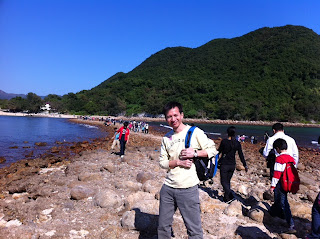

Macau – a different view 25-26 Dec 2008
I’ve been to Macau 4 times and ain’t impressed after a while – Ruins of St. Paul’s and the nearby museum are ok but I’ve been several times. Venetian is huge and beautiful, Fisherman’s Wharf is not too bad, but are they not just another commercialized entertaining places? Most of all, the inescapable image of casino with dazed gamblers is just too depressing for me.
Over this Christmas holidays, I see a different Macau through Helena’s and Moby’s eyes. Macau - a place with many beautiful churches and buildings (mostly painted in yellow and white), a place with a very rich culture and heritage, a place for great value-for-money shopping and dining.
We started our trip with a Christmas mass held at a local school compound. The Irish priest was friendly, the Filipino choir was zealous. The mood was very relaxing and indeed a joyous celebration of our Lord’s birthday!
Somewhere near the intersection of Avenida de Almedia Ribeiro (新马路) and Avenida Da Praia Grande (大马路), there is a special place with many beautiful churches and buildings within short walking distance – St Joseph’s Seminary and Church, St. Augustine’s Church etc. Sadly, some churches are not holding regular mass as the Catholic population dwindles from those days of Portuguese occupation.
We snaked through alleys to reach local shopping arena in Rua de Cinco de Outubro (十月初五街) and Avenida de Horta e Costa (高士德) where we bought good quality simple needs (made-in-China sandals, socks, undies) at amazing prices with good customer service. Along the way, we snacked on pork burger, local cookies/pastries and beancurd. We even took time to relax and exercise our limbs at a local fitness corner.
At Guia Hill (東望洋山), we had a bird eye’s view of Macau. We circled the hill while many locals jogged. At the top of the hill is Guia Fortress where a lighthouse and a church stand.
At Taipa House Museum, we learnt that Macanese (children from inter-marriage between Portuguese and local Asian ethnicities) is mainly Catholic, has close family ties, enjoys having party at home and adopts an unique culture of its own (like that of Peranakan in Malaysia/Singapore).
A trip to Macau is probably not complete without a visit to the Casino, especially in our attempt to get free ferry tickets back to Hong Kong. We gave up – it’s just difficult to gamble for 1 hour (without burning a big hole in our pocket and probably without losing our sensibility).














